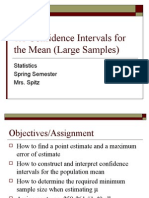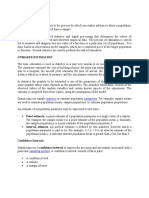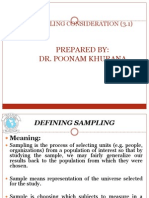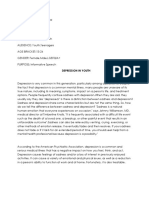Statistical inference basic Class Outline
Uploaded by
akkhanji08Statistical inference basic Class Outline
Uploaded by
akkhanji08Class Outline:
Topic: Basic Estimation & Confidence Interval
Objective: By the end of this class, students should understand point estimation,
interval estimation, construct confidence intervals, and interpret them effectively.
Part 1: Introduction to Estimation
1.1 Population vs. Sample:
Population: A population in statistics refers to the entire group of individuals
or items that we are interested in studying. For example, if we want to know
the average height of all university students, the population includes every
university student.
Sample: A sample is a subset of the population, chosen to represent the entire
group. Since it's often impractical to study the entire population, we collect a
sample and use it to make inferences about the population.
Answer to question:
A population is the complete set of all elements we are interested in, while a
sample is a smaller group taken from the population to represent it.
1.2 Parameter vs. Statistic:
Parameter: A parameter is a value that describes a characteristic of the
population, such as the population mean (denoted μ\muμ).
Statistic: A statistic is a value calculated from the sample, such as the sample
mean (xˉ\bar{x}xˉ), used to estimate the population parameter.
Answer to question:
A parameter is a fixed value describing a population, while a statistic is a
calculated value from a sample used to estimate the parameter.
1.3 Types of Estimation:
Point Estimation:
A point estimate is a single value used to estimate a population parameter. For
example, the sample mean (xˉ\bar{x}xˉ) is a point estimate of the population
mean (μ\muμ).
Question & Answer:
Q: Can we trust point estimates completely?
Answer: No, point estimates give us a single value, but they don't tell us how
precise that estimate is. That’s why we often prefer interval estimates, which
provide a range of values within which the true parameter is likely to lie.
Interval Estimation (Confidence Intervals):
Interval estimation provides a range of values, called a confidence interval,
within which the population parameter is likely to fall. This interval gives
more information than a point estimate because it includes a margin of error.
Question & Answer:
Q: Why do we use intervals instead of just point estimates?
Answer: Interval estimates give us a range that accounts for the uncertainty in
the sample, making it a more reliable representation of the population
parameter.
Example Discussion:
Let's say you collect data on the average time students spend studying. A point
estimate might tell you that the average study time is 4 hours, but an interval estimate
(e.g., 3.5 to 4.5 hours) shows the uncertainty and gives a range within which the true
mean is likely to fall.
Part 2: Confidence Intervals for Population Mean
2.1 Introduction to Confidence Intervals:
A confidence interval (CI) provides a range of plausible values for a
population parameter (such as the mean) based on sample data. A key concept
here is confidence level—the probability that the confidence interval includes
the true population parameter.
For example, a 95% confidence level means that if we repeated the sampling
process many times, approximately 95% of the intervals calculated would
contain the true population mean.
Question & Answer:
Q: What does it mean to say that we are "95% confident"?
Answer: It means that we expect the confidence interval to contain the true
population parameter 95% of the time if we repeated the process many times.
It does NOT mean there's a 95% chance that the true value is within the
current interval.
Answer to question:
Using the t-distribution, the confidence interval is 75.05 to 84.95. The interval
is wider than when using the normal distribution because the t-distribution
accounts for more uncertainty with smaller sample sizes.
Part 4: Key Concepts & Review
4.1 Confidence Level & Margin of Error:
Increasing the confidence level (e.g., from 95% to 99%) increases the width of
the confidence interval because we are requiring more certainty, which
necessitates a larger range.
Question & Answer:
Q: How does increasing the sample size affect the width of a confidence
interval?
Answer: Increasing the sample size decreases the margin of error, which
narrows the confidence interval, providing a more precise estimate of the
population parameter.
Part 4: Key Concepts & Review
4.2 General Review Questions:
What is the difference between a parameter and a statistic?
Answer: A parameter is a fixed value that describes a characteristic of the entire population, while a
statistic is a value calculated from a sample, used to estimate the population parameter.
What is the purpose of a confidence interval?
Answer: A confidence interval provides a range of values that is likely to contain the true population
parameter. It helps account for the uncertainty in the sample estimate.
What does a 95% confidence level mean?
Answer: It means that if we were to take many samples and construct confidence
intervals for each sample, approximately 95% of those intervals would contain the
true population parameter.
How do you calculate a confidence interval when the population standard
deviation is known?
· population standard deviation, and nnn is the sample size.
· What is the difference between using a Z-distribution and a t-distribution
when calculating confidence intervals?
· Answer: The Z-distribution is used when the population standard deviation is known and
the sample size is large. The t-distribution is used when the population standard deviation is
unknown or the sample size is small (n<30n < 30n<30).
· How does increasing the sample size affect the confidence interval?
· Answer: Increasing the sample size decreases the margin of error, resulting in a narrower
confidence interval, which provides a more precise estimate of the population parameter.
· How do you interpret a confidence interval that does not include the
hypothesized population parameter (e.g., population mean)?
· Answer: If the confidence interval does not include the hypothesized parameter, it
suggests that the sample data provides evidence against the hypothesis that the population
parameter is equal to the hypothesized value.
· When constructing a confidence interval for a population proportion, what
formula do you use?
You might also like
- 1 Review of Basic Concepts - Interval EstimationNo ratings yet1 Review of Basic Concepts - Interval Estimation4 pages
- Emath 214 (Engineering Data and Analysis)No ratings yetEmath 214 (Engineering Data and Analysis)2 pages
- Ch 2-Confidence Interval and Sample Size -YARANo ratings yetCh 2-Confidence Interval and Sample Size -YARA27 pages
- 6.1 Confidence Intervals For The Mean (Large Samples)No ratings yet6.1 Confidence Intervals For The Mean (Large Samples)30 pages
- Materi 4 Estimasi Titik Dan Interval-EditNo ratings yetMateri 4 Estimasi Titik Dan Interval-Edit73 pages
- 5 & 6 - BIOSTATISTICS V & VI Inferential Statistics I & IINo ratings yet5 & 6 - BIOSTATISTICS V & VI Inferential Statistics I & II68 pages
- Estimation Sample Statistics Are Used To Estimate Population ParametersNo ratings yetEstimation Sample Statistics Are Used To Estimate Population Parameters2 pages
- Estimation of Population Parameters: 1) Estimating The Population MeanNo ratings yetEstimation of Population Parameters: 1) Estimating The Population Mean19 pages
- Estimating With Confidence: Ms. Plata AP StatisticsNo ratings yetEstimating With Confidence: Ms. Plata AP Statistics31 pages
- Estimation and Sample Size DeterminationNo ratings yetEstimation and Sample Size Determination37 pages
- Chapter 5 Infernece Concerning Mean_081fa6ed Cdae 4e5f Afc5 e9ab156488e0No ratings yetChapter 5 Infernece Concerning Mean_081fa6ed Cdae 4e5f Afc5 e9ab156488e047 pages
- Session 5. Confidence Interval of The Mean When SD Is Known (18-22)No ratings yetSession 5. Confidence Interval of The Mean When SD Is Known (18-22)5 pages
- Lecture 4 Estimating From A Sample Sample Mean and Confidence Intervals Upload 2No ratings yetLecture 4 Estimating From A Sample Sample Mean and Confidence Intervals Upload 222 pages
- FIN 640 - Lecture Notes 4 - Sampling and Estimation100% (1)FIN 640 - Lecture Notes 4 - Sampling and Estimation40 pages
- Data Science Interview Questions - Statistics: Mohit Kumar Dec 12, 2018 11 Min Read100% (1)Data Science Interview Questions - Statistics: Mohit Kumar Dec 12, 2018 11 Min Read14 pages
- Unit-4-Estimation-and-Hypothesis-testing RevisedNo ratings yetUnit-4-Estimation-and-Hypothesis-testing Revised34 pages
- Kajal Srivastava SPM Deptt. S.N.Medical College,: Determining The Size of A SampleNo ratings yetKajal Srivastava SPM Deptt. S.N.Medical College,: Determining The Size of A Sample38 pages
- Basic Statistics 7 Probability and Confidence IntervalsNo ratings yetBasic Statistics 7 Probability and Confidence Intervals22 pages
- Unit - 4 Subject: Business Research Methods: What Is Sampling?No ratings yetUnit - 4 Subject: Business Research Methods: What Is Sampling?10 pages
- 22CS 1st Semester Tabulation Sheet May 2023No ratings yet22CS 1st Semester Tabulation Sheet May 202312 pages
- Quicksort - An Example: Left Left+1 RightNo ratings yetQuicksort - An Example: Left Left+1 Right2 pages
- Writ Petition of Subramanian Swamy On His Fundamental Right To Worship in Ram Mandir (SC, 2016)67% (3)Writ Petition of Subramanian Swamy On His Fundamental Right To Worship in Ram Mandir (SC, 2016)38 pages
- Defining A Mentoring Relationship New MenteesNo ratings yetDefining A Mentoring Relationship New Mentees3 pages
- 2015 Student Ambassador Essay - Hope DiamondNo ratings yet2015 Student Ambassador Essay - Hope Diamond4 pages
- Download Laura Ingalls Wilder 1st Edition Amy Sickels ebook All Chapters PDF100% (3)Download Laura Ingalls Wilder 1st Edition Amy Sickels ebook All Chapters PDF81 pages
- Luciferian Witchcraft - The Mystery RevealedNo ratings yetLuciferian Witchcraft - The Mystery Revealed3 pages
- 6.1 Confidence Intervals For The Mean (Large Samples)6.1 Confidence Intervals For The Mean (Large Samples)
- 5 & 6 - BIOSTATISTICS V & VI Inferential Statistics I & II5 & 6 - BIOSTATISTICS V & VI Inferential Statistics I & II
- Estimation Sample Statistics Are Used To Estimate Population ParametersEstimation Sample Statistics Are Used To Estimate Population Parameters
- Estimation of Population Parameters: 1) Estimating The Population MeanEstimation of Population Parameters: 1) Estimating The Population Mean
- Estimating With Confidence: Ms. Plata AP StatisticsEstimating With Confidence: Ms. Plata AP Statistics
- Chapter 5 Infernece Concerning Mean_081fa6ed Cdae 4e5f Afc5 e9ab156488e0Chapter 5 Infernece Concerning Mean_081fa6ed Cdae 4e5f Afc5 e9ab156488e0
- Session 5. Confidence Interval of The Mean When SD Is Known (18-22)Session 5. Confidence Interval of The Mean When SD Is Known (18-22)
- Lecture 4 Estimating From A Sample Sample Mean and Confidence Intervals Upload 2Lecture 4 Estimating From A Sample Sample Mean and Confidence Intervals Upload 2
- FIN 640 - Lecture Notes 4 - Sampling and EstimationFIN 640 - Lecture Notes 4 - Sampling and Estimation
- Data Science Interview Questions - Statistics: Mohit Kumar Dec 12, 2018 11 Min ReadData Science Interview Questions - Statistics: Mohit Kumar Dec 12, 2018 11 Min Read
- Kajal Srivastava SPM Deptt. S.N.Medical College,: Determining The Size of A SampleKajal Srivastava SPM Deptt. S.N.Medical College,: Determining The Size of A Sample
- Basic Statistics 7 Probability and Confidence IntervalsBasic Statistics 7 Probability and Confidence Intervals
- Unit - 4 Subject: Business Research Methods: What Is Sampling?Unit - 4 Subject: Business Research Methods: What Is Sampling?
- Writ Petition of Subramanian Swamy On His Fundamental Right To Worship in Ram Mandir (SC, 2016)Writ Petition of Subramanian Swamy On His Fundamental Right To Worship in Ram Mandir (SC, 2016)
- Download Laura Ingalls Wilder 1st Edition Amy Sickels ebook All Chapters PDFDownload Laura Ingalls Wilder 1st Edition Amy Sickels ebook All Chapters PDF

























































































